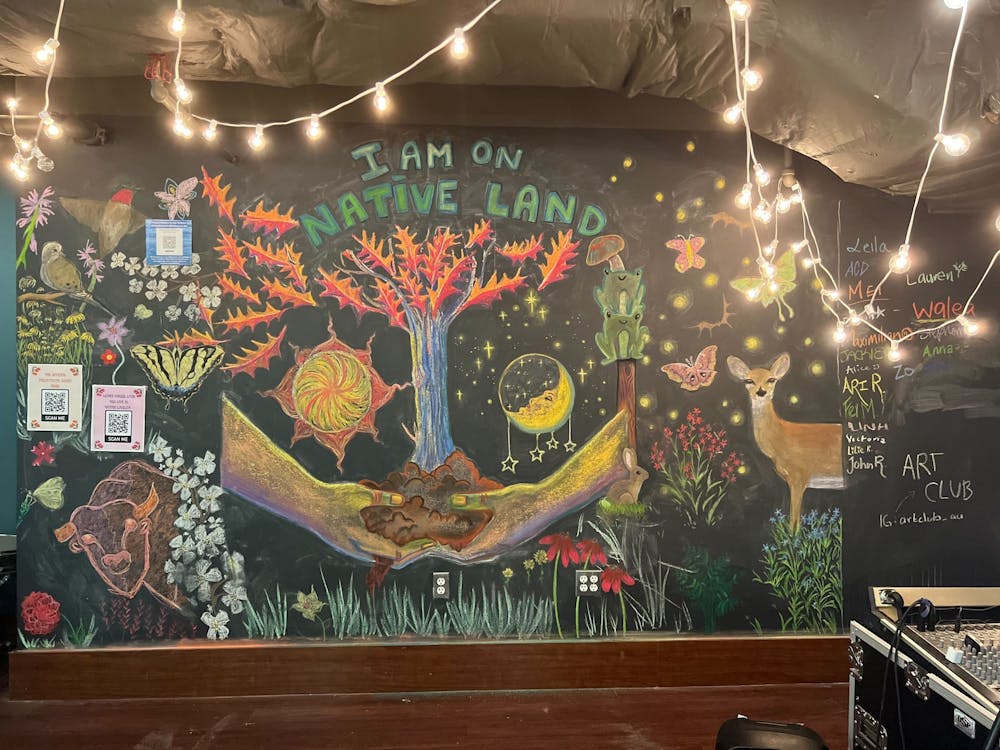Students for Justice in Palestine, Students for a Free Tibet, the AU Hawai’i Club and The Indigenous Initiative joined the AU Art Club for the mural reveal in The Bridge Cafe of the “I Am On Native Land” mural in honor of Indigenous People’s Day in early October.
Along with discussions about the significance of the mural itself, the event included spoken word, poetry and speeches from students discussing and reflecting upon the treatment and representation of Indigenous groups across the globe.
Fatima Garcia, a junior in the School of International Service and the School of Communication and the president of the AU Art Club, said her organization originally got the idea to create a mural in The Bridge after The Bridge Takeover, a student organization that aims to reclaim The Bridge as a space for marginalized communities on campus, began last semester.
“We got together with the people from The Bridge Takeover and talked about … a theme that would create a space for people of color, and we decided to make it about Indigenous land acknowledgment, because we didn't [see] any sort of space or representation… for Indigenous land acknowledgement [on campus],” Garcia said.
The mural is made of chalk and features plants and animals native to the D.C., Maryland and Virginia community in order to honor the Piscataway people native to this land. In the center there is the Scarlet Oak Tree, which is the state tree of D.C. Half of the mural features nocturnal animals while the other half features animals one might see in the daytime.
The top of the mural features the title of the piece: “I Am On Native Land.” This is supposed to serve as a reminder to students that they are currently occupying Native land. Olivia Olson, a junior in SIS and the director of The Indigenous Initiative, said the mural “represents what [the] area was like before it was colonized.”
The mural features several QR codes that students can scan to access educational resources relevant to different Indigenous communities. By scanning the codes, students can learn what native land they are on, visit the Piscataway Tribe’s website, where direct donations can be made to the tribe or donate to the Venmo for the Shutdown Redhill Mutual Aid Organization, which provides supplies and clean water to Indigenous communities in Hawai’i.
Fernanda Martinez, a sophomore in the College of Arts and Sciences and the outreach director and secretary for the E-board of the AU Art Club, explained how the process of creating the mural was also an educational opportunity: “[The mural] started generating awareness … when we were working through it [during] several sessions people would stop by and would ask about it … [the mural] included a lot of AU's community and got them involved and interested.”
The leaders of the student organizations expressed how important it was to bring indigenous groups together for this mural and how they hope the mural will change the discourse on campus about Indigenous students and Indigenous communities across the world.
“A lot of people use [the] phrase: our liberation is connected … it's very important that [this project] included all of these clubs together because the link between all of these indigenous groups … [is to] really combat imperialism and oppression and that can't be done in isolation,” said Lilla Khan, a sophomore in SIS and the vice president of Students for a Free Tibet.
The mural will be up for the entirety of October, and the students that organized the event hope it has an impact on The Bridge.
Mei Matute, a sophomore in SOC and the vice president of the AU Art Club, said, “It's a very visual and beautiful reminder to everyone that comes into the Bridge [that it's] an inclusive space.”
Correction: A previous version of this article included an incorrect spelling of Lilla Khan's name. This article has also been updated to include the correct name of Students for Justice in Palestine.





